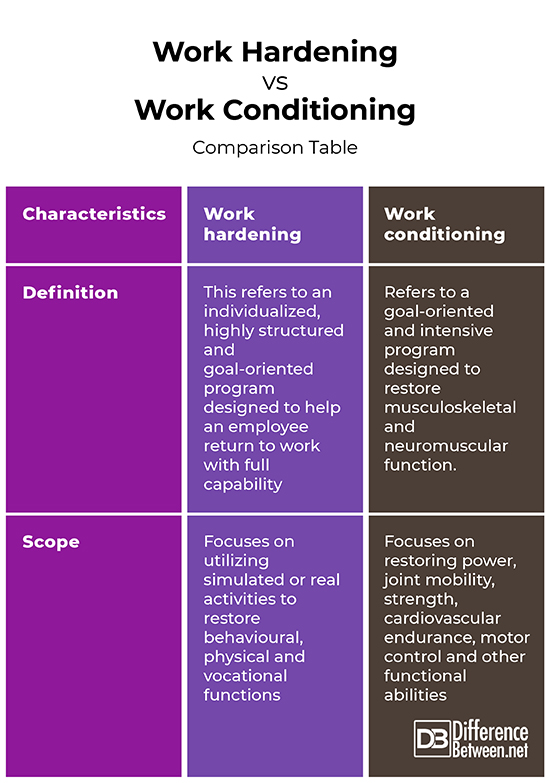Difference Between Work Hardening and Work Conditioning
You may not have experienced an injury in the course of work but you may know someone who had an injury that affected his or her work in one way or another. While recovery may be tasking, various programs such as work hardening and work conditioning come in handy during such periods. Depending on the level of injury, these programs focus on preparing the body to be able to carry out tasks. So, what exactly is the difference between these two programs?

What is Work Hardening?
This is an individualized, highly structured and goal-oriented program designed to help an employee return to work with full capability. To enhance effectiveness, work hardening programs are multidisciplinary in that they utilize simulated or real activities to restore behavioural, physical and vocational functions.
They address issues regarding safety, worker behaviours, physical tolerances and productivity. Vocational specialists, physical therapists, psychologists or occupational therapists can be consulted for work hardening.

What is Work Conditioning?
This is a goal-oriented and intensive program designed to restore musculoskeletal and neuromuscular function. These include power, joint mobility, strength, cardiovascular endurance, motor control and other functional abilities. All these functions are carried out to enable a worker to return to his or her pre-injury work functions.
These programs also benefit people who work in heavy physical-demand level occupations such as climbing, pushing, pulling, crawling and carrying heavy materials. To enable workers to gain the confidence to safely return to work, these activities can be performed in a controlled environment.
Similarities between Work hardening and Work conditioning
- Both aim to restore the functionality and the ability of a worker to work fully and safely
Differences between Work hardening and Work conditioning
Definition
Work hardening refers to an individualized, highly structured and goal-oriented program designed to help an employee return to work with full capability. On the other hand, work conditioning refers to a goal-oriented and intensive program designed to restore musculoskeletal and neuromuscular function.
Scope
While work hardening focuses on utilizing simulated or real activities to restore behavioural, physical and vocational functions, work conditioning focuses on restoring power, joint mobility, strength, cardiovascular endurance, motor control and other functional abilities.
Work hardening vs. Work conditioning: Comparison Table

Summary of Work hardening vs. Work conditioning
Work hardening refers to an individualized, highly structured and goal-oriented program designed to help an employee return to work with full capability. It focuses on utilizing simulated or real activities to restore behavioural, physical and vocational functions.
On the other hand, work conditioning refers to a goal-oriented and intensive program designed to restore musculoskeletal and neuromuscular function. It focuses on restoring power, joint mobility, strength, cardiovascular endurance, motor control and other functional abilities
Both programs can, however, benefit labour intensive professionals such as police officers, firefighters, plumbers, mechanics, construction workers, healthcare providers and chefs, just to name a few.
- Difference Between Profit Center and Investment Center - July 2, 2022
- Difference Between Anti-Trust and Anti-Competition - June 6, 2022
- Difference Between Stocktaking and Stock Control - June 6, 2022
Search DifferenceBetween.net :
Leave a Response
References :
[0]Rathmell J & Fishman S. Bonica's Management of Pain. Lippincott Williams & Wilkins, 2010. https://books.google.co.ke/books?id=Pms0hxH8f-sC&pg=RA1-PA1499&dq=Difference+between+Work+hardening+and+Work+conditioning&hl=en&sa=X&ved=2ahUKEwilw_mFz-LqAhWRsBQKHSJHAXEQ6AEwBHoECAEQAg#v=onepage&q=Difference%20between%20Work%20hardening%20and%20Work%20conditioning&f=false
[1]Rathmell J & Fishman S. Bonica's Management of Pain. Lippincott Williams & Wilkins, 2010. https://books.google.co.ke/books?id=Pms0hxH8f-sC&pg=RA1-PA1499&dq=Difference+between+Work+hardening+and+Work+conditioning&hl=en&sa=X&ved=2ahUKEwilw_mFz-LqAhWRsBQKHSJHAXEQ6AEwBHoECAEQAg#v=onepage&q=Difference%20between%20Work%20hardening%20and%20Work%20conditioning&f=false
[2]Phyllis M. King. Sourcebook of Occupational Rehabilitation. Springer Science & Business Media, 2013. https://books.google.co.ke/books?id=rnH1BwAAQBAJ&pg=PA257&dq=Difference+between+Work+hardening+and+Work+conditioning&hl=en&sa=X&ved=2ahUKEwilw_mFz-LqAhWRsBQKHSJHAXEQ6AEwAnoECAMQAg#v=onepage&q=Difference%20between%20Work%20hardening%20and%20Work%20conditioning&f=false
[3]Ward A & Mahle A. Adult Physical Conditions: Intervention Strategies for Occupational Therapy Assistants. F.A. Davis, 2018. https://books.google.co.ke/books?id=PCZZDwAAQBAJ&pg=PA429&dq=Difference+between+Work+hardening+and+Work+conditioning&hl=en&sa=X&ved=2ahUKEwilw_mFz-LqAhWRsBQKHSJHAXEQ6AEwA3oECAQQAg#v=onepage&q=Difference%20between%20Work%20hardening%20and%20Work%20conditioning&f=false
[4]Image credit: https://cdn.pixabay.com/photo/2020/07/24/10/01/person-5433457_1280.png
[5]Image credit: https://www.peakpx.com/496526/2-man-working-image
